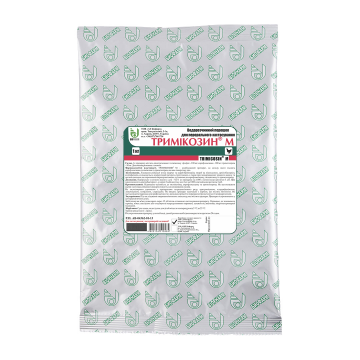TRIMICOSIN® М
water-soluble powder for oral administration
Description
Yellowish-white powder.
Composition
1 g of the drug contains:
active ingredients: tilmicosin phosphate – 100 mg;
enrofloxacin- 100 mg;
trimethoprim- 50 mg;
Excipient: glucose.
water-soluble powder for oral administration
Description
Yellowish-white powder.
Composition
1 g of the drug contains:
active ingredients: tilmicosin phosphate – 100 mg;
enrofloxacin- 100 mg;
trimethoprim- 50 mg;
Excipient: glucose.
Pharmacological properties
ATCvet: QJ01– antibacterials for systemic use. QJ01RA91 quinolones, combinations with other antibacterials
Trimicosin® М is a combined drug containing enrofloxacin, tilmicosin and trimethoprim, with a synergistic action.
Enrofloxacin is a broad-spectrum antibiotic of the fluoroquinolone group. It has antibacterial acction against gram-positive (Staphylococcus spp., Streptococcus spp., Clostridium spp., Listeria monocytogenes, Corynebacterium spp. etc.) and gram-negative microorganisms (Pseudomonas spp., E. coli, Haemophilus spp., Salmonella spp., Klebsiella spp., Proteus spp., Pasteurella spp. etc.), as well as mycoplasma (Mycoplasma spp.) and chlamydiae (Chlamidia spp.). Its mechanism of action is related to inhibition of bacterial DNA-gyrase, resulting in violation of DNA replication in microorganisms.
Trimethoprim is a broad-spectrum antimicrobial product of diaminopyrimidine group. It is effective against gram-positive (Staphylococcus spp.; Streptococcus spp.) and gram-negative microorganisms (E. coli, Klebsiella spp., Salmonella spp.; Pasteurella spp., Enterobacter spp., Proteus spp., Shigella spp., Haemophilus spp.), as well as toxoplasma and coccidia. The mechanism of action consists in inhibition of the enzyme dihydrofolate reductase in tetrahydrofolic acid synthesis. It provokes depletion of folate, the main cofactor in the synthesis of nucleic acids, resulting in disruption of their synthesis, and bacterial protein formation.
Tilmicosin is a semisynthetic antibiotic antibiotic of the macrolides group, with bacteriostatic effect in low concentrations, and bactericidal effect in high concentrations on gram-positive and gram-negative microorganisms, namely: Pasteurella spp., Haemophilus spp., Actinomyces spp., Corynebacterium spp., Clostridium perfringens, as well mycoplasma (Mycoplasma spp.). The mechanism of tilmicosin action consists in blocking of protein synthesis in the bacterial cell by forming a complex with 50S subunits of ribosomes.
Enrofloxacin is quickly absorbed from digestive tract and well distributed in body tissues and fluids. Its maximum concentration in blood is reached already in 60-120 minutes. Feed in the stomach does not affect drug absorption. Binding of enrofloxacin to proteins makes 24±2%. The highest enrofloxacin concentrations are observed
in bile, kidneys, liver, lungs and reproductive organs. Enrofloxacin is primarily excreted renally. Metabolites are excreted in urine and feces.
Trimethoprim is quickly absorbed from digestive tract and well distributed in body tissues and fluids. Trimethoprim concentrations in tissues are generally higher than in the blood. High levels of Trimethoprim are present in lungs, kidneys and liver. Trimethoprim concentration
in serum reaches its maximum in 1.5 after administration. Average half-life makes about 2.5 hours. Trimethoprim is metabolized in liver and is primarily excreted renally through glomerular filtration and active tubular secretion. Its concentration in urine is much higher than in blood.
Tilmicosin is well absorbed from digestive tract. It accumulates in respiratory organs and macrophages in poultry in concentrations, considerably exceeding the concentration in blood serum. It is preserved in respiratory organs and tissues in therapeutic concentrations for over 2.5 days. It is metabolized with formation of several metabolites with antibacterial activity. It is primarily excreted in feces.
Administration
Treatment of mycoplasmosis, ornithobacteriosis, colibacillosis, salmonellosis, necrotic enteritis, streptococcosis as well as other diseases of digestive tract and respiratory organs caused by enrofloxacin-, tilmicosin- and timetoprim-sensitive microorganisms in poultry (chickens and broiler chickens).
Dosage
Administer orally with drinking water in a dose of 0.5-1 kg of the drug per 1000 l of drinking water for 3 days. For mycoplasmosis and ornithobacteriosis - in the first 3 days of life at a dose of 1 kg per 1000 l of drinking water for 3 days.
Contraindications
Hypersensitivity to tilmicosin, enrofloxacin and trimethoprim.
Do not administer to hens, laying eggs for human consumption.
Do not administer in combination with tetracycline drugs, erythromycin, chloramphenicol, lincomycin, theophylline and steroids.
Do not administer the drug with feed containing bentonites.
Do not use in animals for prevention and in cases of direct or cross-resistance of microorganisms.
Precautions
Special precautions for administration
During treatment, animals are given only water with the drug. The dissolved drug shall be used within 24 hours. Do not prescribe the drug in sub-therapeutic doses and animals with hypersensitivity to the drug components.
Interaction with other drugs or other forms of interaction
Simultaneous oral use with drugs, containing Mg2 +, Al3 +, Ca2 +, may reduce enrofloxacin absorption.
Excretion (withdrawal) period
Poultry slaughter for meat is possible in 12 days following the last administration of the drug. Meat, obtained before the mentioned term, shall be utilized or fed to non-productive animals depending on the statement of a veterinary physician.
Packaging
Packages made of film or foil materials of 100 g and 1 kg.
Storage
Store in a dry dark place out of the reach of children at 5-25 °С.
Shelf life - 2 years.
24 hours after drug dissolution in drinking water.
For use in veterinary medicine!
